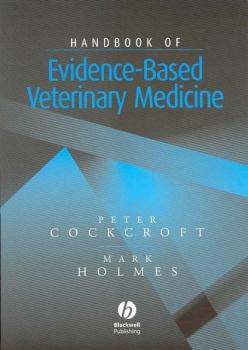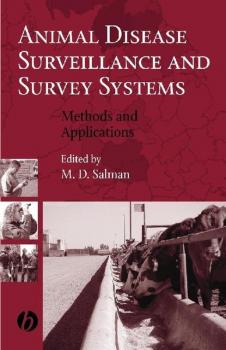ТОП просматриваемых книг сайта:
Медицина
Различные книги в жанре Медицина, доступные для чтения и скачиванияАннотация
Hair Loss Disorders in Domestic Animals is an in-depth reference on the pathomechanisms and clinical approaches of all skin diseases in domestic animals that have hair loss as the predominant clinical feature. It presents both basic and clinically-relevant knowledge on alopecic disease in animals. This text is a one-of-a-kind resource providing cutting-edge coverage of the physiology and pathology of hair follicles. Disease-specific chapters include: a detailed description of the disease entity, etiology, pathogenesis, clinical and histopathological diagnosis and treatment modalities.
Аннотация
Integrating complementary treatment options with traditional veterinary practice is a growing trend in veterinary medicine. Veterinarians and clients alike have an interest in expanding treatment options to include alternative approaches such as Western and Chinese Herbal Medicine, Acupuncture, Nano-Pharmacology, Homotoxicology, and Therapeutic Nutrition along with conventional medicine. Integrating Complementary Medicine into Veterinary Practice introduces and familiarizes veterinarians with the terminology and procedures of these complementary treatment modalities in a traditional clinical format that facilitates the easy integration of these methods into established veterinary practices.
Аннотация
Pet behavior problems are a leading cause of pet abandonment, relinquishment, abuse and neglect. As a reliable and educated source, veterinarians must help guide their clients in the right direction. Blackwell's Five-Minute Veterinary Consult Clinical Companion: Canine and Feline Behavior facilitates veterinarians in counseling clients and treating small animal behavior problems. As part of the popular Blackwell's Five-Minute Veterinary Consult series, this unique manual is designed as a quick reference for veterinarians and students alike. Information is readily available in a practical and easy-to-use format, with topics organized alphabetically for easy reference. Coverage includes typical problem behaviors in dogs and cats, such as various types of aggression, anxiety, fear, soiling and marking, vocalizing, and destructive behaviors. Appendices provide additional resources on psychopharmacology, learning and behavior modification, and client handouts, which can be downloaded electronically for easy use.
Аннотация
The application of evidence-based veterinary medicine (EBVM) can assist in improving and optimising the diagnosis, prognosis, control, treatment and ultimately the welfare of animals. It can also provide the user with a methodology for appropriate, patient orientated life-long, self-directed, learning. To practise evidence-based veterinary medicine we require a range of skills that we may not have. This book explains what evidence-based veterinary medicine is and shows how it can be applied to veterinary practice to improve the quality of care for patients and provide informed choices for owners. It provides the reader with a toolkit of skills necessary to practise evidence-based veterinary medicine. This book is aimed at practitioners but will be of interest to veterinary surgeons at any stage of their training or career wishing to learn about EBVM.
Аннотация
The diversity of species in which drugs are used for clinical purposes and the emphasis on various classes of drugs make veterinary pharmacology a complex subject. Anatomical and physiological features influence the pharmacokinetic behaviour of a drug in a particular animal and the dosage required. This book is concerned with the basis of species differences, the selection of pharmacokinetic parameters and the interpretation of values obtained. There are chapters on bioavailability and its application to veterinary dosage forms, changes in drug disposition and interspecies scaling, clinical selectivity and stereoisomerism, drug permeation, antimicrobial disposition and specifics related to neonatal animals. The author has gathered all this information together in one place so allowing the reader to make better selection of drug preparations for animal dosages to effectively treat animal diseases. The book will prove valuable to clinical researchers in the areas of pharmacology, anaesthesia, microbial infections and, internal medicine as well as postgraduate students of these disciplines. The Author J Desmond Baggot (MVM, PhD, DSc, FRCVS, DipECVPT) is currently Visiting Professor of Veterinary Pharmacology at the School of Veterinary Medicine, St George's University, Grenada, West Indies. He was a contributing author and co-author of Antimicrobial Therapy in Veterinary Medicine, 3rd Edition (2000) and Development and Formulation of Veterinary Dosage Forms, 2nd Edition (1998) and the author of Principles of Drug Disposition in Domestic Animals (1977). Elucidations of the processes that underline species variation in the disposition of drugs and interpretation of the influence of disease states on drug disposition have been the focus of his research endeavours. He was a member of the Editorial Board of the Journal of Veterinary Pharmacology and Therapeutics from 1978 to 1996. He is a former Professor of Clinical Pharmacology at the School of Veterinary Medicine, University of California, Davis and Preclinical Veterinary Studies at the University of Zimbabwe, Harare.
Аннотация
Veterinarians, technicians and wildlife caregivers are often called upon to have expertise in raising infant mammals. This book provides clear guidance to raising and caring for a wide variety of domestic, farm, wildlife, and zoo mammals from birth to weaning. Over thirty veterinary technicians, wildlife specialists, and veterinarians from around the world have contributed their expertise to this useful book that covers over 50 mammalian species. Some of the topics covered in each chapter of this book include: * Assessment of the neonate * Specialised equipment * Expected weight gains * Formula selection and preparation * Weaning techniques * Housing * Common medical problems Detailed chapters are devoted to the following animals: * Domestic animals: puppies, kittens, ferrets, sugar gliders and rabbits * Farm animals: foals, kids, llamas and piglets * Wildlife: squirrels, opossums, raccoons, rabbits, deer, foxes, bears, bats, and hedgehogs * Zoo animals: ungulates, non-domestic equids, exotic felids, polar bears, elephants, rhinoceroses, macropods, pinnipeds, large and small primates, lemurs and sloths Dr Laurie Gage is well known for her work and expertise in the rearing of seals, sea lions and walruses and has experience in rearing many other mammalian species.
Аннотация
The application of evidence-based veterinary medicine (EBVM) can assist in improving and optimising the diagnosis, prognosis, control, treatment and ultimately the welfare of animals. It can also provide the user with a methodology for appropriate, patient orientated life-long, self-directed, learning. To practise evidence-based veterinary medicine we require a range of skills that we may not have. This book will explain what evidence-based veterinary medicine is and show how it can be applied to veterinary practice to improve the quality of care for patients and provide informed choices for owners. It will provide the reader with a toolkit of skills necessary to practise evidence-based veterinary medicine. The authors explain how to: · Transform information needs into a series of clinical questions that can be answered · Search for best available external evidence · Critically appraise the evidence for its validity and importance · Apply the results in clinical practice · Understand the process of diagnosis and use of clinical diagnostic decision support systems · Perform a decision analysis This book is aimed at practitioners but will be of interest to veterinary surgeons at any stage of their training or career wishing to learn about EBVM. The authors are responsible for devising and teaching an EBVM course at the veterinary school at Cambridge. Dr Peter Cockcroft, Clinical lecturer, Department of Clinical Veterinary Medicine, University of Cambridge.
Аннотация
This much-anticipated third edition again consolidates the knowledge of more than twenty experts on pathogenesis of animal disease caused by various species or groups of bacteria. Emphasizing pathogenic events at the molecular and cellular levels, the editors and contributors place these developments in the context of the overall picture of disease. Pathogenesis of Bacterial Infections in Animals, Third edition, updates and expands the content of the second edition and includes cutting-edge information from the most current research. Comments on previous editions: «…highly recommended.» –The Veterinary Record «…a comprehensive, complete and easy-to-use source of information.» –Veterinary Microbiology «…recommended for graduate students and specialists in microbiology, pathology and infectious disease.» –U.S. Animal Health Association Newsletter «…a wonderful book.» –Journal of the American Veterinary Medical Association «…highly recommended.» –The Cornell Veterinarian Graduate students, faculty, researchers, and specialists in microbiology, pathology, and infectious diseases will benefit from this highly-detailed and expanded edition of a popular and well-read veterinary text.
Аннотация
Complementary and Alternative Veterinary Medicine Considered is a book that belongs in your veterinary library. If you are a veterinarian wondering if you should incorporate complementary and alternative veterinary medicine (CAVM) into your practice, if you have recently hired an associate eager to try such things as acupuncture or homeopathy, or if you have clients asking you about chiropractic, herbal, or magnetic field therapy for their pets, you’ll want to understand the history, science and ethics behind such therapies. In its 2001 Guidelines for Complementary and Alternative Medicine, the American Veterinary Medical Association (AVMA) recognizes the growing interest in CAVM, and encourages the critical examination of these therapies using the scientific method. Following the AVMA’s lead on this subject, Complementary and Alternative Veterinary Medicine Considered thoroughly examines a variety of CAVM therapies and asks important questions regarding alternative treatments. For example, is acupuncture effective in pain relief? What is homeopathy? What is the history behind chiropractic? What does the research say (and not say) about various CAVM modalities? And, just as importantly, what are the ethical and regulatory considerations concerning such therapies? This book has the answers to those questions and more. Complementary and Alternative Veterinary Medicine Considered will help practicing veterinarians to make informed decisions about specific CAVM therapies. This text evaluates various prevalent therapies, and will give veterinarians the ethical and scientific bases they need to make sound decisions regarding CAVM therapies Coverage includes but is not limited to: Acupuncture and acupressure; Energy medicine; Manual therapy (chiropractic); Manual therapy (massage); Magnetic and electromagnetic therapy; Laser and light therapy; Homeopathy; and Herbal therapy.
Аннотация
This valuable text presents methods and techniques for conducting an animal disease surveillance program, and developing an animal health moitoring system. The text is a 'recipe book' for these techniques as it explains modern techniques, while emphasizing the fundamentals and principles of using these techniques.The book is targeted to epidemiologists and other animal health authorities who are working in national, regional, and international programs. The book can be used as a text for professional and postgraduate training curricula. This text will be of value in veterinary epidemiology and regulatory medicine, where there is need for a concise collection of material on animal disease monitoring, surveillance, and reporting strategies. This need arises from a new era of international trade regulations based on animal diseases, new demands for accountability in utilization of research funds, and calls for prioritizing and economically justifying animal health regulatory and diagnostic activities.










